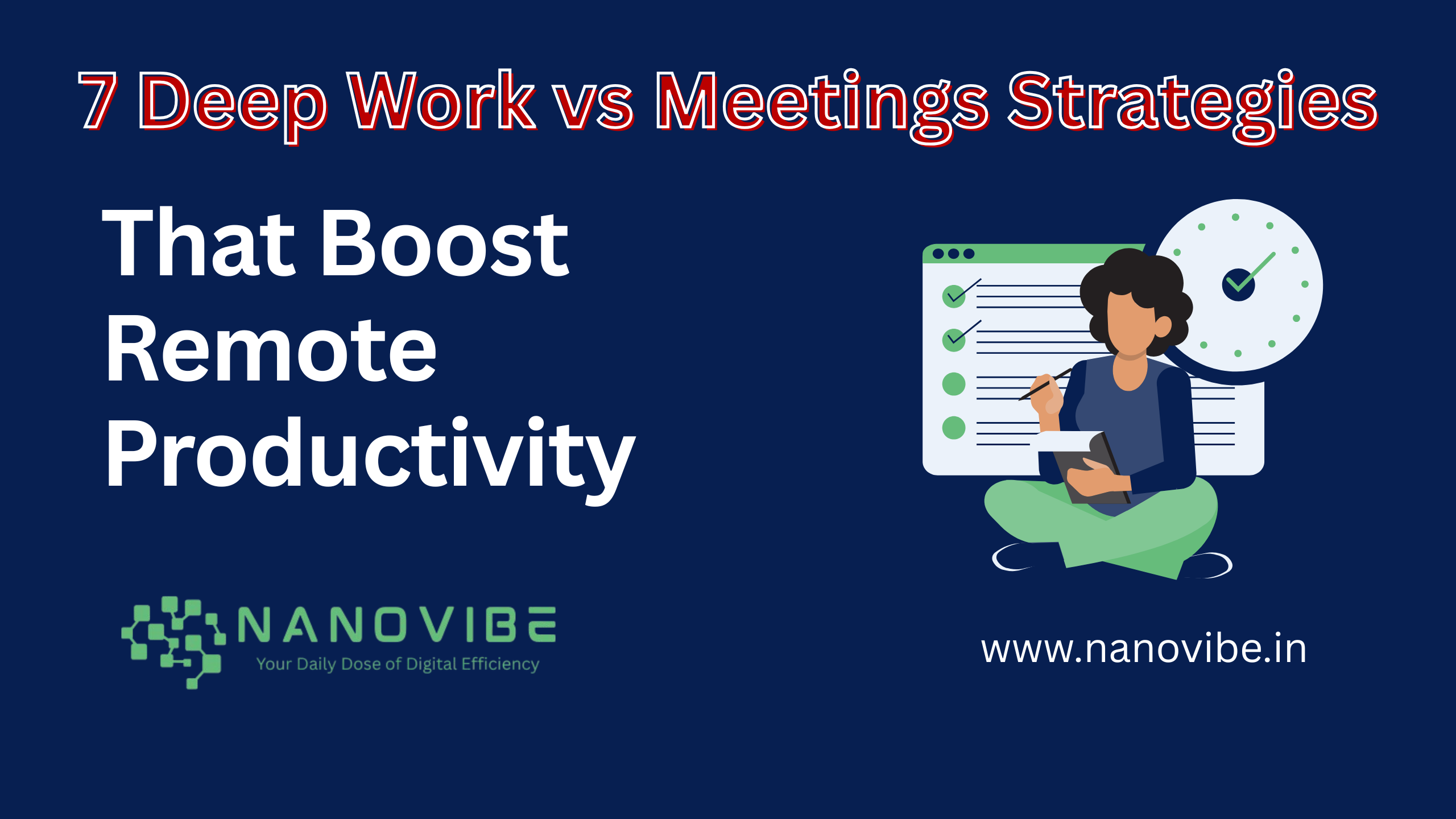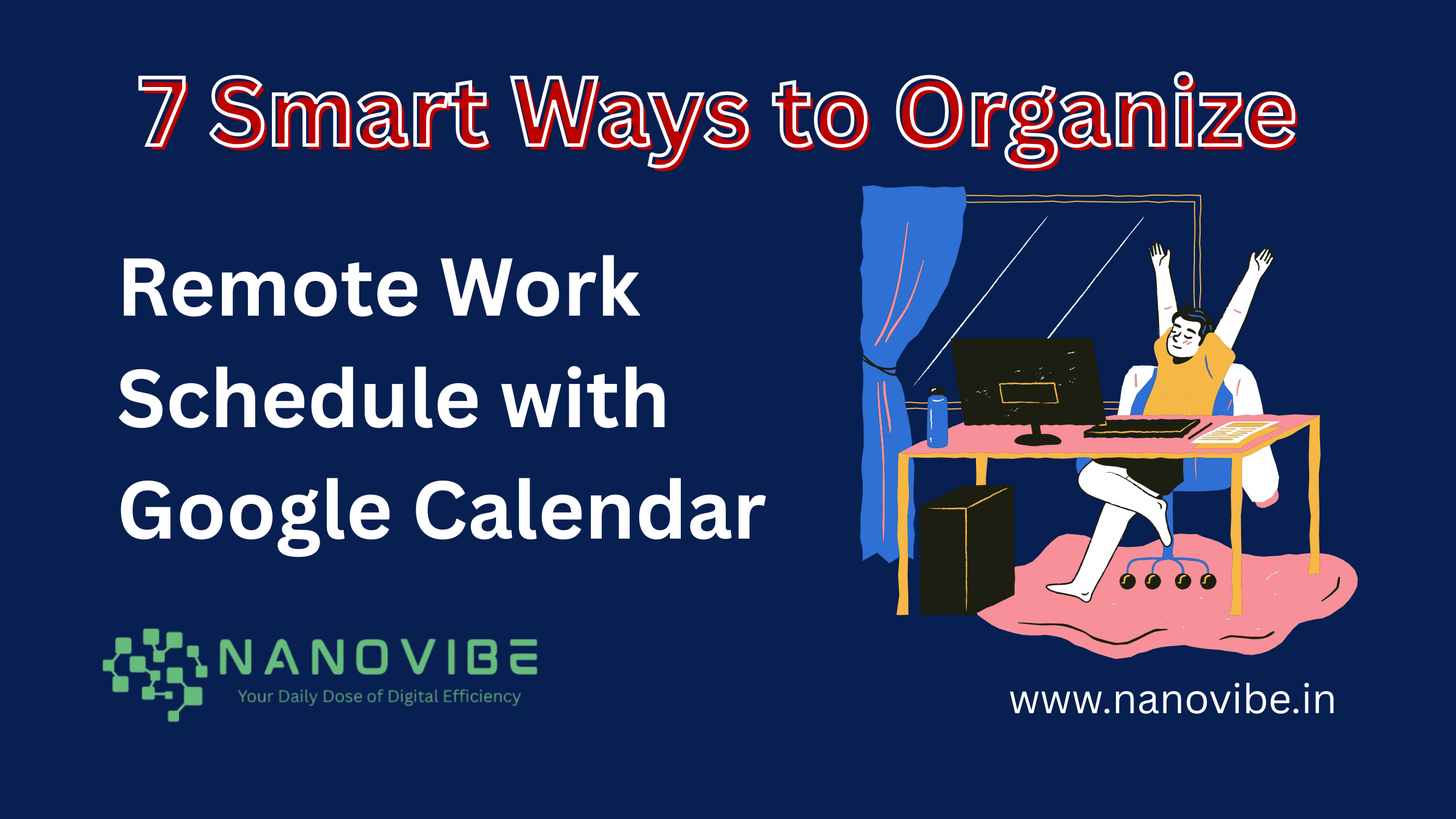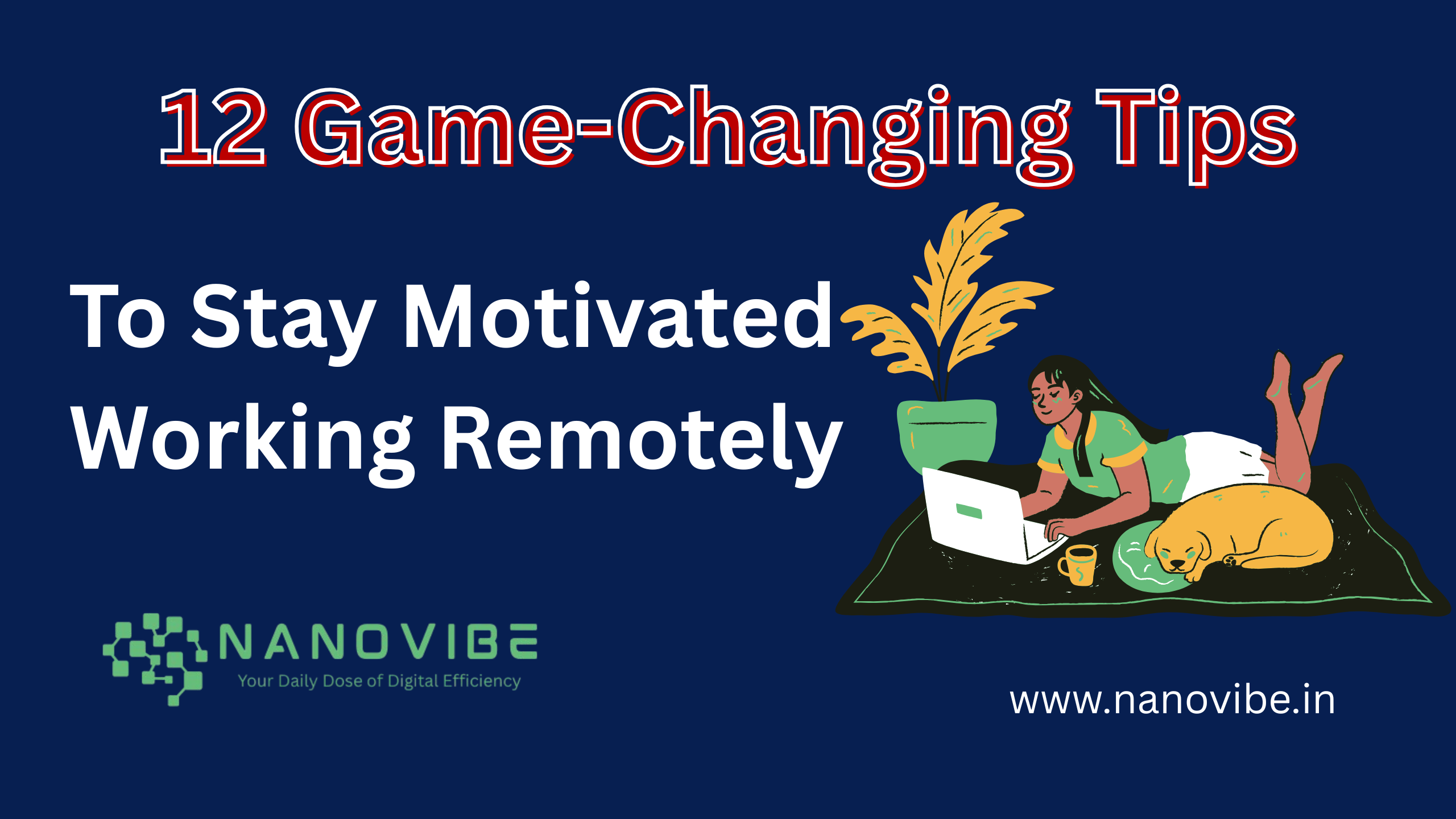In a remote-first world, achieving a healthy balance between deep work and virtual meetings is one of the most overlooked productivity challenges. As teams become increasingly distributed across time zones and platforms, professionals must juggle focused work sessions for remote employees with the constant pull of Zoom calls, Slack notifications, and team check-ins.
While both structured meetings and deep, focused work have their place, it’s the imbalance that causes friction. Too many remote meetings during the workday can fragment attention and lead to mental fatigue. On the flip side, working in isolation without touch points can hinder team alignment, collaboration, and decision-making.
Balancing time-blocking strategies for deep work with effective communication rituals is now a core skill in the modern workplace. In fact, research from Owl Labs shows that remote employees spend 25% more time in meetings compared to their in-office counterparts a trend that, without intervention, can diminish the quality of actual work output.
This article dives deep into how to balance deep work vs meetings for remote teams in a way that supports productivity, collaboration, and well-being. Whether you’re an individual contributor trying to reclaim focus time or a team leader optimizing workflows, these strategies will help you align deep work priorities with meaningful team interactions.
How to Balance Deep Work and Meetings Effectively
In the world of remote work, productivity often hinges on one critical challenge: balancing deep work vs meetings. While deep work is essential for producing high-quality output, meetings are necessary for collaboration, alignment, and communication. But when meetings dominate the day, they leave little room for focused work. So how do high-performing remote teams manage both without sacrificing either?

In this article, we’ll explore how to strike the right balance between deep work and meetings, offer actionable strategies, share insights backed by data, and provide SEO-enhancing external links to deepen your knowledge.
What Is Deep Work?
The term Deep Work was popularized by Cal Newport in his book Deep Work: Rules for Focused Success in a Distracted World. It refers to uninterrupted, distraction-free periods where you can focus intensely on cognitively demanding tasks.
Characteristics of Deep Work:
- No notifications or emails
- No multitasking
- Time-blocked for 90–120 minutes
- Focused on high-value, strategic tasks
Common examples of deep work in remote jobs:
- Writing a long-form blog post or report
- Coding and debugging
- Creating design prototypes
- Planning strategic roadmaps
At its core, deep work is not just about working harder it’s about working smarter and deeper. It represents a mental state where distractions are stripped away, and full attention is channeled into tasks that require intense brainpower and deliberate concentration. Unlike surface-level work like answering emails or attending low-stakes meetings deep work is immersive, cognitively demanding, and highly valuable.
A Zone Where Time Disappears
You’ve likely experienced moments where time seemed to blur when you were so absorbed in creating, coding, analyzing, or writing that you forgot to check your phone, didn’t notice messages piling up, and felt completely “in the zone.” That’s deep work in its purest form. It’s where breakthroughs happen and your most meaningful contributions emerge.
This flow state, often discussed by psychologists like Mihály Csíkszentmihályi, isn’t accidental it’s the result of intentional focus and controlled attention. But reaching it in a remote setting takes discipline, structure, and sometimes cultural permission from your team or organization.
Why It’s More Important Than Ever
In the digital age, attention has become the most scarce and valuable resource. Notifications, chats, and constant updates fragment your day, leaving little room for extended focus. For remote professionals, especially, the challenge isn’t lack of time but lack of uninterrupted mental space.
What makes deep work so powerful is that it enables you to:
- Solve complex problems without restarting your thought process.
- Produce high-quality output faster, with fewer revisions.
- Feel more satisfied at the end of the day, knowing you’ve made real progress.
And unlike shallow work, which can often be delegated or automated, deep work creates original value. It’s the difference between checking tasks off a list and building something meaningful that drives your career, project, or business forward.
Deep Work Is a Skill Not Just a Habit
One of the biggest misconceptions is that deep work is simply about blocking time on your calendar. While scheduling is part of it, deep work is more like a muscle. It needs to be trained, protected, and strengthened over time. This means:
- Practicing intentional focus even when distractions are present.
- Recognizing the mental cost of context switching.
- Learning how to “warm up” into complex tasks rather than jumping between tabs or apps.
Mastering this mindset helps you build a resilience to noise and pressure a vital skill in today’s hyper-connected work environments.
It’s Not About Isolation It’s About Depth
Deep work doesn’t mean shutting out your team or avoiding communication. In fact, some of the most impactful deep work happens in collaborative environments like engineers solving bugs together, marketers brainstorming campaigns, or designers refining user flows.
What distinguishes it from meetings or multitasking is the depth of thought and the intentional space it requires. It’s less about doing more, and more about doing what matters most without interruption, and with full cognitive presence.
Also Read: 7 Elements Every Daily Schedule for Remote Workers Should Include
What Are Meetings in Remote Work?
Meetings are collaborative sessions usually virtual that enable team members to sync, align, brainstorm, or make decisions. Tools like Zoom, Microsoft Teams, and Google Meet have become the backbone of remote meetings.
Common Types of Remote Meetings:
- Daily standups
- Weekly check-ins
- 1:1 performance reviews
- Client calls
- Team retrospectives
However, excessive meetings often become productivity blockers. A 2022 study by Atlassian revealed that employees attend an average of 62 meetings per month, and half of them are considered unnecessary.
In a traditional office, meetings often unfold organically hallway conversations, impromptu huddles, or scheduled conference room chats. In remote work, however, meetings take on a different shape and weight. They are often the primary moments of live connection planned, digital, and more structured. As a result, they play a vital role in maintaining alignment, transparency, and culture but only when used intentionally.
More Than Just a Zoom Call
Remote meetings aren’t just about checking boxes or replicating the in-office experience they’re about bridging the gap between physical distance and shared purpose. Whether it’s a team sync, project kickoff, or a 1:1 performance conversation, meetings create space for:
- Real-time collaboration
- Clarifying misunderstandings
- Driving key decisions forward
- Human connection in otherwise isolated workdays
Yet, in many organizations, what starts as a necessity can quickly become a burden. When meetings aren’t thoughtfully designed, they evolve into digital clutter draining time, energy, and focus.
The Double-Edged Sword of Remote Meetings
Unlike office settings, remote meetings require far more mental energy. There are no non-verbal cues, eye contact is limited, and communication relies heavily on verbal clarity and stable internet. Add screen fatigue to the mix, and it’s easy to see why remote professionals often feel exhausted after a few back-to-back calls.
This is why not all meetings are created equal in a distributed environment. A 15-minute virtual check-in can offer clarity and direction, while a poorly managed hour-long session can leave everyone more confused than before. The difference lies in intent, not just length.
Redefining What a Meeting Is
In the remote world, the definition of a “meeting” is evolving. It’s no longer confined to everyone being online at the same time. With the rise of asynchronous communication tools like Loom, Slack threads, and shared docs, teams now have more flexibility to collaborate without adding more meetings to the calendar.
What’s considered a meeting in one company might be handled via voice notes or shared dashboards in another. The most agile teams use a mix of formats live video, async updates, recorded demos to achieve the same goals while respecting each team member’s focus time.
The Real Purpose of Remote Meetings
At their best, meetings are accelerators they eliminate ambiguity, spark innovation, and create alignment across time zones and roles. At their worst, they’re disruptors fragmenting the day, derailing momentum, and stalling productivity.
To ensure meetings support, rather than sabotage, deep work:
- Every meeting should have a clear goal and defined outcome
- Participants should know why they’re attending
- The session should respect everyone’s time, attention, and energy
It’s not about having fewer meetings it’s about having better ones.
Also Read: How to Stay Motivated Working Remotely: 12 Game-Changing Tips That Actually Work
Deep Work vs Meetings: The Core Conflict
The conflict between deep work vs meetings lies in their structure:
| Aspect | Deep Work | Meetings |
|---|---|---|
| Focus | Solo, uninterrupted | Collaborative, often interruptive |
| Goal | Produce high-quality output | Share information or make decisions |
| Time Requirement | 90+ minutes | 15–60 minutes |
| Environment | Quiet, distraction-free | Social, dynamic, verbal |
Too many meetings interrupt the flow required for deep work, leading to context switching, which reduces productivity by up to 40%, according to the American Psychological Association.
Why Balancing Deep Work and Meetings Matters
- Improved Productivity: Time for deep work enables more meaningful output, while meetings ensure alignment.
- Reduced Burnout: Constant context switching leads to cognitive fatigue.
- Higher Job Satisfaction: Employees value uninterrupted time to accomplish meaningful tasks.
According to Buffer’s State of Remote Work, 32% of remote workers struggle with too many meetings, making it one of the top productivity killers in distributed teams.

Strategies to Balance Deep Work and Meetings
Striking the right balance between meetings and focused work isn’t about choosing one over the other it’s about designing your day with intention. Below are actionable, research-backed strategies that help remote professionals and teams manage their time more effectively without compromising productivity or communication.
1. Create Meeting “Zones” Within Your Workday
One of the most effective ways to reduce disruption is to assign specific time blocks for meetings typically in the middle or later part of the day. This tactic ensures your brain’s peak energy hours, usually in the morning, are preserved for high-focus work.
Example: Schedule all non-urgent meetings between 1 PM–4 PM, leaving 9 AM–12 PM for deep work sessions.
This separation helps eliminate random interruptions and creates rhythm and predictability in your day.
2. Align Meetings to Weekly Objectives
Instead of scheduling meetings reactively, align them with weekly deliverables or sprint goals. This ensures that each meeting has a strategic purpose and doesn’t eat into productive time without contributing to results.
Ask yourself:
“Does this meeting directly move a project forward?”
If not, it may be better handled asynchronously or pushed to a more strategic time slot.
3. Use ‘Silent Work Hours’ as a Team Policy
Consider implementing team-wide silent hours a stretch of the day where no meetings, pings, or calls are allowed. Popularized by productivity-first organizations, silent hours are ideal for deep thinking, execution, and creative output.
Remote-first companies like Doist have adopted this policy to support uninterrupted work across time zones.
4. Turn Recurring Meetings into Asynchronous Updates
Recurring meetings are often the biggest culprits when it comes to calendar clutter. Try replacing status updates or team check-ins with asynchronous video messages (e.g., via Loom) or short written reports.
This lets team members consume the information on their own schedule, keeping mornings free for heads-down work.
5. Use AI and Automation to Handle Routine Communication
Don’t manually chase updates or feedback when automated tools can do the job. Platforms like Zapier, Slack integrations, or project management dashboards (e.g., Notion, Asana) can automate status tracking and reduce the need for check-in meetings.
This approach frees up more time for strategic conversations and even more for deep work.
6. Design an Ideal Week Template
Rather than planning day-by-day, outline a recurring weekly structure that reflects your work priorities. Include blocks for deep work, collaborative time, and admin tasks. This “ideal week” framework becomes your baseline for scheduling, helping prevent overload from unscheduled requests or last-minute meetings.
Even if every week isn’t perfect, having a structure reduces decision fatigue and keeps your priorities in focus.
7. Prioritize Decision-Making Meetings Over Informational Ones
Not all meetings are created equal. Give priority to meetings where real decisions are made. These sessions should be well-prepared, concise, and driven by clear outcomes. Informational meetings updates, check-ins, announcements can often be condensed, combined, or replaced with written summaries.
Ask: “What action will come out of this meeting?”
If the answer is unclear, reconsider its necessity.
8. Build Team Norms Around Focus and Communication
Lastly, balancing deep work vs meetings isn’t just a personal task it’s cultural. Work with your team to define communication norms:
- When to use Slack vs. email vs. meetings
- How much notice is required for scheduling
- What qualifies as urgent
When everyone is on the same page, it’s easier to protect deep work time without risking team misalignment.
Also Read: 7 Smart Ways to Organize Remote Work Schedule with Google Calendar
Bonus Tips for Remote Teams to Optimize Deep Work and Meetings

Remote work offers flexibility, but without proper structure, it can easily lead to fragmented focus, miscommunication, and meeting overload. Once you’ve laid the foundation for balancing deep work and meetings, here are some advanced tips for remote teams to fine-tune that balance and create a more productive, focused workflow.
Rotate Meeting Leads to Share Responsibility and Reduce Fatigue
Having the same person run every meeting can lead to repetition and mental fatigue. Rotate meeting leads weekly to keep sessions dynamic, while giving everyone a deeper sense of ownership. This approach also strengthens team accountability and improves the overall quality of communication.
Encourage “Virtual Office Hours” Instead of Constant Pings
Rather than interrupting each other throughout the day with ad-hoc messages, encourage your team to establish virtual office hours specific time blocks where they’re open to chat or answer questions. This minimizes disruptions and protects deep work periods without isolating team members.
Implement a ‘Last Meeting of the Day’ Rule
End your day with your final meeting no later than a designated time (e.g., 4:00 PM local time). This gives employees a protected window to close out the day with undisturbed focus or personal reflection essential for sustainable productivity and well-being.
Use Visual Task Boards to Reduce Verbal Check-ins
Switching from frequent verbal updates to visual task tracking can drastically reduce meeting needs. Use Kanban-style boards (like Trello, ClickUp, or Jira) so everyone sees project status at a glance, decreasing the need for redundant status calls.
Incorporate Micro-Breaks Into Your Deep Work Schedule
Burnout doesn’t always stem from overworking it often comes from lack of recovery. Encourage your team to schedule 5–10 minute breaks between deep work blocks. This small shift helps sustain attention and creative energy throughout the day.
Conduct Monthly “Meeting Audits” as a Team Ritual
Once a month, review your team’s meetings collectively. Identify which ones are no longer serving a purpose or could be condensed. This encourages ongoing reflection and helps foster a culture of respect for people’s time and attention.
Define Deep Work Signals for Team Awareness
Establish a universal “focus signal” your team can use such as a Slack emoji status, Do Not Disturb toggle, or calendar note to indicate when someone is in a deep work zone. This prevents unintentional interruptions and builds mutual respect for quiet time.
Celebrate Outcomes, Not Hours Spent in Meetings
Remote productivity shouldn’t be measured by how many calls a person attends, but by the value they create. Shift your culture toward outcome-based recognition whether that’s completing a strategic report, launching a campaign, or solving a technical bug. This reduces performative “busy work” and encourages quality over quantity.
Conclusion
Balancing meetings and deep work is not a one-size-fits-all solution. It’s a mindset shift from reactive to intentional work. By implementing systems that guard your focus while still facilitating collaboration, you’ll not only get more done but get the right things done.
Balancing deep work with meetings isn’t just about scheduling it’s about rethinking how remote teams operate, communicate, and measure success. By weaving in intentional practices, respecting focus time, and adopting smarter workflows, your team can avoid burnout while operating at a high level.
Whether you’re managing a global workforce or freelancing from home, these remote team productivity tips can help you create a culture that values both collaboration and concentration without sacrificing either.




